#Home-Based Literacy Development
Explore tagged Tumblr posts
Text
Literacy Support - It Starts at Home!
In today’s fast-paced world, the responsibility for fostering literacy often seems to rest solely on schools. However, foundational literacy starts long before a child enters the classroom. Parents and guardians are their children’s first and most influential teachers. By embracing this critical role, families can lay the groundwork for a lifetime of learning and literacy success. Why Literacy…

View On WordPress
#Building Foundational Literacy Skills#Creating a Print-Rich Home Environment#Early Literacy Tips for Parents#Everyday Activities to Teach Reading#Family Reading Time Ideas#Home-Based Literacy Development#How to Support Literacy at Home#Importance of Reading to Your Child#Literacy Strategies for Busy Parents#Parental Role in Child Literacy
0 notes
Text
"Across the country, thousands of public schools face closures due to low enrollment.
But Detroit, Michigan-based nonprofit Life Remodeled is welcoming vacant schools into a new era.
The organization, which has invested $51 million in revitalizing Detroit neighborhoods, primarily works to purchase vacant properties and work with dozens of area organizations to provide life-changing resources to community members.

Its first remodel — the Durfee Innovation Society — opened in 2023. A former elementary and middle school, the building is now what the organization calls “an opportunity hub,” providing resources like after-school programs, career preparedness, and support in accessing healthcare, financial literacy, and more.
“The Durfee Innovation Society is an Opportunity Hub,” Brandy Haggins, the director of the project, told CBS News. “We call it that because we’ve taken an old school building that probably would have set back vacant, and we housed it with the best and brightest nonprofits in Detroit.”
She continued: “An Opportunity Hub is a place where individuals can come and get opportunities that they deserve, that they probably otherwise would not have access to.”
The building is home to over 35 organizations, including Nursing Detroit, Big Brothers Big Sisters, and Starfish Family Services.
Since it opened, the Durfee Innovation Society has provided 3,400 Detroit students with after-school programming, 5,600 with job opportunities, and 13,400 children and families with resources and support.
Ultimately, the organization says, 22,000 Detroiters take part in Durfee’s programs every year.
These numbers represent exciting milestones, but they are also in competition with what Life Remodeled is up against.
According to the organization, 88% of third graders in Detroit read below grade level. 30% of Detroiters can’t access the healthcare they need. And Detroit residents’ median household income is 50% less than suburban residents.
School closures impact low-income communities hardest, with low enrollment rates causing school districts to consolidate resources — and infrastructure.
In 2017, Durfee Elementary School merged with a local high school, and Life Remodeled swooped in to save the space.
“It’s not just community history; It’s personal history for a lot of people,” Haggins told CBS News in 2024. “What better way to work with the community than to reopen their school building into something that still belongs to them?”

The services available at the hub are free to anyone in the community. Nonprofits housed there pay for their space “at cost,” meaning they only pay what it takes to keep the building up and running.
It’s a model that seems to be working.
“The best part about being involved is seeing the actual change be made,” Charles Spears, the youth alliance president for Durfee Innovation Society, told CBS News. “You know, a lot of people talk about it. But when you get to see first hand, you actually see what is happening. It’s just like, wow, there is literally opportunity for all.”
Now, Life Remodeled is onto their next project: another “opportunity hub” on the east side of Detroit. The new property, formerly Winans Performing Arts Academy, is a 90,000-square-foot space that plans to open in December of 2025.
It’s called Anchor Detroit, and it’s located in the Denby community — an area in which residents “face significant poverty and lack access to opportunities related to educational attainment, job opportunities, and health and wellness resources,” according to a press release from Life Remodeled.
More than 50,000 square feet of the space will be leased by nonprofit partners, who will bring more after-school youth programs, workforce development initiatives, and health resources to the area...
Anchor Detroit is currently being renovated to prepare for its reopening and will reportedly include a “significant presence” for arts and culture programs.

Once it opens, Life Remodeled estimates the new space will support 18,000 community members per year.
“This should be a nationwide model for other schools that have closed across the country,” Haggins told CBS News. “I think taking a school building, or any historical building that means something to a community, and repurposing it into something that’s for the community — that’s huge and necessary.”"
-via GoodGoodGood, February 5, 2025
#detroit#michigan#united states#north america#community#community support#nonprofit#resources#poverty#schools#infrastructure#good news#hope
1K notes
·
View notes
Text
Things the Biden-Harris Administration Did This Week #32
August 30-September 6 2024.
President Biden announced $7.3 billion in clean energy investment for rural communities. This marks the largest investment in rural electrification since the New Deal. The money will go to 16 rural electric cooperatives across 23 states Alaska, Arizona, California, Colorado, Florida, Illinois, Indiana, Iowa, Kentucky, Michigan, Minnesota, Montana, Nebraska, New Jersey, New Mexico, Nevada, North Dakota, Ohio, Pennsylvania, South Dakota, Texas, Wisconsin, and Wyoming. Together they will be able to generate 10 gigawatts of clean energy, enough to power 5 million households about 20% of America's rural population. This clean energy will reduce greenhouse emissions by 43.7 million tons a year, equivalent to removing more than 10 million cars off the road every year.
The Biden-Harris Administration announced a historic 10th offshore wind project. The latest project approved for the Atlantic coast of Maryland will generate 2,200 megawatts of clean, reliable renewable energy to power 770,000 homes. All together the 10 offshore wind projects approved by the Biden-Harris Administration will generation 15 gigawatts, enough to power 5.25 million homes. This is half way to the Administration's goal of 30 gigawatts of clean offshore wind power by 2030.
President Biden signed an Executive Order aimed at supporting and expanding unions. Called the "Good Jobs EO" the order will direct all federal agencies to take steps to recognize unions, to not interfere with the formation of unions and reach labor agreements on federally supported projects. It also directs agencies to prioritize equal pay and pay transparency, support projects that offer workers benefits like child care, health insurance, paid leave, and retirement benefits. It will also push workforce development and workplace safety.
The Department of Transportation announced $1 billion to make local roads safer. The money will go to 354 local communities across America to improve roadway safety and prevent deaths and serious injuries. This is part of the National Roadway Safety Strategy launched in 2022, since then traffic fatalities have decreased for 9 straight quarters. Since 2022 the program has supported projects in 1,400 communities effecting 75% of all Americans.
The Department of Energy announced $430 million to support America's aging hydropower. Hydropower currently accounts for nearly 27% of renewable electricity generation in the United States. However many of our dams were built during the New Deal for a national average of 79 years old. The money will go to 293 projects across 33 states. These updates will improve energy generation, workplace safety, and have a positive environmental impact on local fish and wildlife.
The EPA announced $300 million to help support tribal nations, and US territories cut climate pollution and boost green energy. The money will support projects by 33 tribes, and the Island of Saipan in the Northern Mariana Islands. EPA Administer Michael S. Regan announced the funds along side Secretary of the Interior Deb Haaland in Arizona to highlight one of the projects. A project that will bring electricity for the first time to 900 homes on the Hopi Reservation.
The Biden-Harris Administration is investing $179 million in literacy. This investment in the Comprehensive Literacy State Development Grant is the largest in history. Studies have shown that the 3rd grade is a key moment in a students literacy development, the CLSD is designed to help support states research, develop, and implement evidence-based literacy interventions to help students achieve key literacy milestones.
The US government secured the release of 135 political prisoners from Nicaragua. Nicaragua's dictator President Daniel Ortega has jailed large numbers of citizens since protests against his rule broke out in 2018. In February 2023 the US secured the release of over 200 political prisoners. Human rights orgs have documented torture and sexual abuse in Ortega's prisons.
The Justice Department announced the disruption of a major effort by Russia to interfere with the 2024 US Elections. Russian propaganda network, RT, deployed $10 million to Tenet Media to help spread Russian propaganda and help sway the election in favor of Trump and the Republicans as well as disrupting American society. Tenet Media employs many well known conservative on-line personalities such as Benny Johnson, Tim Pool, Lauren Southern, Dave Rubin, Tayler Hansen and Matt Christiansen.
Vice-President Harris outlined her plan for Small Businesses at a campaign stop in New Hampshire. Harris wants to expand from $5,000 to $50,000 tax incentives for startup expenses. This would help start 25 million new small business over four years.
#Thanks Biden#Joe Biden#kamala harris#climate change#climate action#wind power#Russia#human rights#politics#US politics#america politics#worker's rights#road safety
1K notes
·
View notes
Text
Astrology observations 🌸🌷🌸

Credit goes to my Tumblr blog @astroismypassion
With Neptune Square MC you probably don't see yourself in a »typical« career. Also, other people or the public so to say has a false understanding of your role in the society, your status, career and even about your relationship with your parents. You are confused about your profession or your life path. You quite literally might need to pretend in your job (such as being an actor) or you feel like you cannot be you, but instead play a role (counsellor). There is a barrier of illusion here, because in your career you cannot be just you, but it's often a role you are »pretending« for.
Moon opposite Chiron: with Chiron hitting the Moon here, there is usually an emotional vulnerability from the past (either from the family or the mother) and you feel it comes up again and again in your relationships. You often feel emotions are »too much« or you don't feel understood emotionally enough. You have felt that it is not safe to express your feelings at home. Yet now you deeply understand other's emotions, but at the same time you are scared of emotional closeness.
Uranus square Pluto: you often feel repressed, restricted in a public job or working for another's company. You like going against the norm. You may lose your job and randomly start your own company, because you don't like to be controlled. Only when you are in crisis or chaos, you actually end up making a change.
Jupiter trine Saturn: you build things really slowly in life. You often approach it with structure and a vision with a plan. You may even help build a school or a company. This aspect is very much »start up« energy.
Pluto in the 4th house, you grew up in a family where there was survelliance of some sort or family member were too critical. This rarely means actual death of a family member, but instead you lost something very important, like divorce of your parents or loss of a healthy family dynamic. You felt you couldn't trust emotions and relationships at home, so at times you have a hard time trusting others or have a hard time building long-term, stable relationships. Feelings of safety, protection and love were not openly expressed. Or they were conditioned with power, control or sometimes even fear. One parent usually had weak control or was completely physically or emotionally absent. You may feel that you don't know who you really are when you peel off outer mask or the influence of your family. You may often move, renovate your home or quite literally lose it and build a new one. Or you destroy everything what you had and build new emotional and physical connections. You could also move far away due to feeling of releasing the burden of family legacy or to break from your heritage, inherited patterns. You may not be as patriotic too, almost like there is sort of disdain for your home country. There is an indirect transfer of trauma from a family member, you feel like you carry the weight of events you didn't directly experienced.
Lilith in the 4th house is tricky. I would say even more than Pluto in the 4th, because at least Pluto can »reintroduce« themselves and transform many points in life. Lilith here touching your roots, emotional world, family, what can end up happening is you isolating yourself a lot. You often have a feeling of rebellion or being left out like a general feeling or feeling you experience at home or with your family. But often you isolate, when you don't work through your past family patterns. Usually this placement later on builds a home and a family life completely based on their own terms and principles.
If you have North Node in the 2nd house, yeah figure out your values in life as soon as possible. Because when you don't, you end up being too giving and sacrifical to others. In this lifetime, you need to develop financial literacy, develop talents and practical skills. Your life lesson will be learning to be self-sufficient, knowing your worth and creating generational wealth basically. You probably came from emotional dependency or an environment with addiction, substance abuse problems, but you need to learn stable confidence in your adulthood.
Surprisingly, Uranus in the 12th house is that one low-key placement that could ALSO indicate having a feeling of leading a double life. And what I mean by this, you have your outter mundane, normal life and an inner life full of »aha moments«, deep transformations, secret rebellion, resentment towards the old structures or anything that you deem too conventional in community. There is this feeling that the real »you« is hidden or within you, but not visible to others. You have an inner understanding that you are different from others, but you never say that to others or share this with others, you keep quiet.
With Neptune in the 12th house, here a double life could also be found. But from much different reasons than Uranus in the 12th. There are usually troubles differenciating between what's real and what's ficional, imaginative or illusory. So you often don't say anything, because you feel others just won't understand or see you as someone »just a little odd«.

Credit goes to my Tumblr blog @astroismypassion
#astrology#astroismypassion#astro notes#astroblr#astro community#astro note#astro observations#natal chart#astrology blog#chart reading
365 notes
·
View notes
Text
Blitzø and BPD: Character Analysis
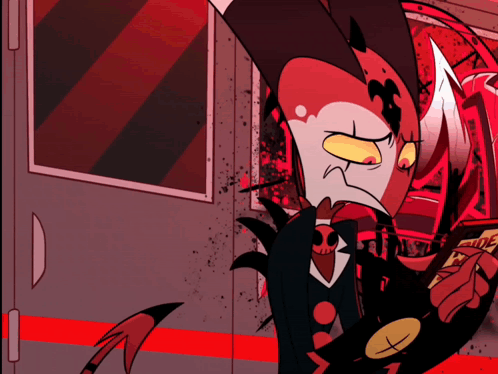
Hey everyone! Finally going to write the character analysis i’ve wanted to do for so long now. It’s gonna be long, so get ready.
IMPORTANT NOTE
I have borderline personality disorder (BPD). This is based off of not only my own experience, but the general symptoms too. Whether or not Blitzø was intentionally written this way, i have no clue. If you disagree with me that’s fine, but please don’t be an asshole about it.
What is BPD?
For this, i will be using the Mayo Clinic definition and symptoms.

What leads to BPD? Usually, a traumatic or neglectful childhood, and possibly genetics as well. Typically develops in adulthood, however for me it developed at the end of middle school. I grew up being emotionally neglected and could never hold friendships for very long. But this isn’t about my trauma, it’s about Blitzø’s.
If we look at Blitzø’s childhood, we can see that the trauma is there for BPD to develop.

First of all, his father, Cash Buckzo. He’s an alcoholic, raising two children in the circus. Based on Blitzø’s lack of literacy we can assume he got minimal education. Not to mention that it’s clear Cash likes Fizzarolli more than Blitzø, despite not being biologically related. Blitzø grew up knowing his father loved him less.
While we don’t really know anything about his mom, we can assume she may have been sick, based on Cash’s line, “don’t you wanna help me and your mama out?” Followed by Blitzø responding, “of course i wanna help mama!” His mom seemed to be the more loving person in the family, and that will be important later. Blitzø and Barbie clearly loved her.
Blitzø also struggled in the circus, never being able to impress the audience.

Though of course, when Fizz was there, it went well. Fizz carried Blitzø’s acts in the circus, making the horse balloon when Blitzø couldn’t. Blitzø grew jealous knowing that he was a disappointment to his father. He wasn’t loved by him. Fizz was.
And god, i wish we knew fucking anything about Barbie. As i said before, my biggest issue with this show is how it’ll fully develop every male character before even glancing at the women. I really hope they get better with this.
But moving on, it’s clear that despite his jealousy, Blitzø cared deeply about Fizz. But that would all fall apart one day.
Blitzø held a card with a flower in hand, meant for Fizzarolli on his birthday. This implies he may have had romantic feelings for him, but we don’t know 100%. Blitzø tries to walk into the main area, but sees his dad give Fizz a card that says “I wish you were my son.”
This was Blitzø’s breaking point.
He’s had enough, he gave up. He pushed aside the imp carrying the cake, and that was his biggest mistake.
The fire.

It was truly an accident. But it was an accident that would shape Blitzø for the rest of his life. Because of his mistake, he lost his home. he lost his mother. his sister and father survived with seemingly minimal injury, but Fizz got the worst of it. Because of Blitzø.
And all he could do was run. Run away, and find help.
Unfortunately, we do not know the details of what happened post fire. All we know is Cash did everything to keep Blitzø and Fizz apart.

Cash more than ever likely hated his son, hated him for injuring the imp he valued so, so much more. So he told Blitzø Fizz didn’t want to see him, and told Fizz Blitzø would never come see him. Cash set it into Blitzø’s mind that Fizz hated him now. And it stuck.
I think Blitzø’s BPD developed pretty soon after this. He was still a teenager, but probably close to being an adult.
Now, lets finally get into the main bits.
Symptoms
I will go over when I believe Blitzø displays the 9 BPD critieria, throughout the whole show.
As described by Mayo Clinic, the 9 criteria are:
- A strong fear of abandonment. This includes going to extreme measures so you're not separated or rejected, even if these fears are made up.
- A pattern of unstable, intense relationships, such as believing someone is perfect one moment and then suddenly believing the person doesn't care enough or is cruel.
- Quick changes in how you see yourself. This includes shifting goals and values, as well as seeing yourself as bad or as if you don't exist.
- Periods of stress-related paranoia and loss of contact with reality. These periods can last from a few minutes to a few hours.
- Impulsive and risky behavior, such as gambling, dangerous driving, unsafe sex, spending sprees, binge eating, drug misuse, or sabotaging success by suddenly quitting a good job or ending a positive relationship.
- Threats of suicide or self-injury, often in response to fears of separation or rejection.
- Wide mood swings that last from a few hours to a few days. These mood swings can include periods of being very happy, irritable or anxious, or feeling shame.
- Ongoing feelings of emptiness.
- Inappropriate, strong anger, such as losing your temper often, being sarcastic or bitter, or physically fighting.
During S1 Ep 1 & 2, we don’t really see much of Blitzø’s more internal feelings. The most we get is the moment with robo Fizz, where he says that no one loves him but he’s “really good with guns now”. Blitzø doesn’t yet see the appreciation I.M.P has for him.
1. strong fear of abandonment
We see this a lot. I first want to point out episode 3, where we begin to learn more about Blitzø.

Blitzo cares so much about Loona. The second he loses sight of her, he panics. Then he finds her talking to Vortex, and gets angry. Blitzø does not want to lose Loona. He has done everything he could for her, from letting her use the one bedroom in their apartment to letting her have a job at his business. He can’t risk someone taking her away. So when Loona gets pissed at him he plays it off like he normally does, but we can tell he’s pained by it.
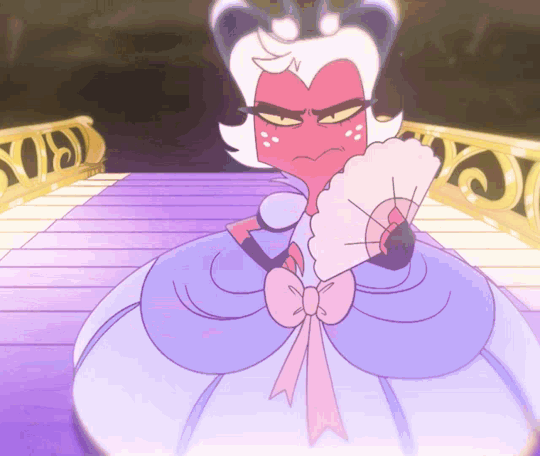
We also see more of this in episode 6, in my favorite sequence of the whole show, the Bad Trip. The voice of Moxxie in Blitzø’s head calls out how he’s scared that one day, everyone else will get sick of his behavior and leave. This is an extremely common fear in BPD. The fear of dying alone.
Blitzø says it himself in episode 8. “I’m gonna die alone aren’t I? Just a wrinkly, old, weathered, waste.”
However, my favorite example of this is in S2 E2.

Blitzø gets an intense flashback to when he adopted Loona. His care for Loona is so deep that he’s willing to kill people if it means they won’t be separated.
Or of course, how he acts in Full Moon when he thinks Stolas is going to take away his access to the living world forever.
2. Pattern of intense/unstable relationships
Definitely the most apparent symptom Blitzø displays. We already discussed how his relationship with Fizz got ruined, so let’s start at Verosika.
Blitzø and Ver’s relationship was thrilling. He probably came into a lot of notoriety, dating someone of her level of fame. However, there relationship was focused more on the sex and partying, not the love. But Verosika saw more for them, she believed they could have a romantic life. So she confessed.
One of the worst parts of BPD: self sabotage. Blitzø’s guilt complex was too immense, he truly believes he fucked up too much to ever love again. So when Ver says she loves him, he runs away. He likely loved her too, but he couldn’t risk hurting her that way. So he left, without a word.
Then of course the elephant in the room: Stolas. This is already long enough so let’s keep this just at their status in season 2.
Obviously, Blitzø does not think Stolas actually loves him. At all. How could he love an imp, especially this one? The one who ruined everything?
But deep down, Blitzø does want more. He does care. You probably remember the line from S2 E4(or 5 i always mix them up):
“Stolas got what? He can get hurt?”
As season 2 progresses, Blitzø slowly realizes that Stolas does care. That Stolas is not that different from him. Blitzø loves Stolas too, but hates himself so much he can’t imagine being loved back.

And this is why Blitzø acts how he does in the beginning of Apology Tour. When he angrily tells Stolas he won’t ever say sorry to him, it’s not out of hate. This is another common BPD trait, beginning to resent the ones you love, because you cannot fathom that they love you too. As we see throughout the episode Blitzø desperately wants to say sorry to Stolas, but keeps pushing it off. He doesn’t want Stolas to leave.
3. Quick Changes in how you see yourself
Blitzø does frequently split on his self worth, which you can catch if you pay attention to his dialogue. Staying on Apology Tour, here’s one of my favorite examples of this:

Blitz, not wanting to admit he turns people away due to guilt, says "I'm too much Imp to simp." but then like a minute later he lets it out to Stolas, confessing he doesn't understand how anyone could love him for who he is. Blitz pretends that he sees himself as this sexy demon everybody wants but cannot have, but that facade can break within seconds. Blitz regularly tries to convince himself he's just too good for anyone and that's why his life is this way.
I also think Blitz playing as Bethany GhostFucker is a good example of this. he's pretending to be someone he's not, someone he thinks is admirable, someone who has what he wants.
Another key example of the fact that Blitzo regularly masks is one of my favorite background details in the whole show.

Blitz has countless photos of his loved ones on his wall, but he always marks out his own face. Proof that he only pretends that he has an ego.
4. Periods of Stress-related paranoia/Loss of touch with reality
Blitz has lost contact with reality before, however the two mostly notable times were not solely caused by his own mind, outside forces started it. The bad trip was due to truth gas, and the hotel demon possessed Blitz. However, going back to Seeing Stars, Blitz again did completely lose touch with reality for a moment, when he remembered adopting Loona. Blitz is paranoid though, he fears losing Loona, losing Stolas, losing Millie, etc. But that is more of symptom one. If someone has a good example of symptom four please let me know.
5. Impulsive and Risky behavior
here's another one Blitz does a lot.

Relating back to when Blitz broke up with Ver, he did something that seems incredibly unwarranted and cruel.
"You gonna run off leaving someone else to pay for the hotel room? Steal their car and run three rings to Wrath and max my credit cards on shitty horse riding lessons?!"
Yes, this was a cruel action from Blitz, but with the context of his disorder it makes sense as to why he did it. Blitz self sabotaged. He impulsively chose to make Verosika resent him, so he ran away, stole her car, and spent all her money. This is not a defense of his actions, but an explanation, which you can probably understand if you think critically.
Another key example is from my favorite episode, GhostFuckers. Blitz is absolutely swamped after the party, and has completely ruined his savings through impulsive purchasing.
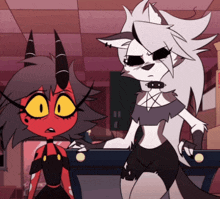
He made Loona stay up all night to deal with his impulse-bought taxidermy owls, Moxxie has to figure out how to save the company from bankruptcy, and Blitz is completely neglecting all self care. He's binge-eating, watching a porno show all day, hoping he'll just die of diabetes or something.

we also saw how Blitz got so insanely wasted that even the Sin of Gluttony got concerned.
6. Threats of Suicide and or/self harm
I don't particularly think there's any good examples of this in the show. but if you have one, let me know.
7. Wide mood swings that last from hours to days
I think the GhostFuckers situation is very similar to this. As well as in Apology Tour, but his mood changes more so based on the development of the argument. I think overall his Ghostfuckers situation is the best example, as that episode had likely lasted for at least a full day. Blitz does experience a whole array of feelings in that one episode, from feeling excited over pretending to be Bethany, to angry at Millie, then feeling like a disgusting monster that shouldn't even be touched. The last symptom of impulsive anger is more like him and we will get to that soon.
8. Ongoing Feeling of emptiness
Guess what. Ghostfuckers again !!!! Blitz has a massive void in his heart post Apology Tour, and wastes away his time refusing to be productive.

I also generally think Blitz felt empty after Ozzie's, mindlessly scrolling his phone through the pictures of his old memories.

He only broke when he remembered his mother.
9. Inappropriate, Strong anger
we see this a lot with him. Blitz regularly snaps at people, often always at very, very bad times.

There's all the times he's threatened Moxxie, Yelled at the lady in the hospital, wasn't afraid to talk shit to Mammon's face, got kicked out of a coffee shop, and so many other times. Blitz has impulsive anger that he clearly struggles to control.
Conclusion
Blitz's symptoms have negatively affected his life, from losing partners and friends, neglecting his personal care, and putting himself in great danger.
but he's getting better.

It starts at Apology Tour. He admits he wants to change. That's the first step.
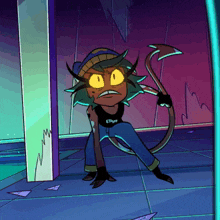
Then Millie, a friend, reassures him that change is possible. That he has someone he can lean on. That he's not irredeemable.
Blitz has changed so many people's lives for the better. He got Loona out of her hellish life in the adoption center. He put a light in Stolas's life. He made Millie realize she's more than just a simple Wrathian. He got Moxxie out of jail.
And because of that,

he has people who love him.
Blitz is changing. His reformation arc has begun and I believe in season 3 we will see a different side of him. Because he's not an emotionless assassin. He's broken, but the pieces can be put back together.

and that's why he's my favorite character in the whole series, and one of my favorite characters period.
if you read all this, thank you. I hope this made some sense, and please let me know what you think.
#helluva boss#blitzo helluva boss#blitzo#stolitz#verosika mayday#millie helluva boss#moxxie helluva boss#stolas goetia#stolas helluva boss#hellaverse#vivziepop#cash buckzo#fizzarolli helluva boss#fizzarolli#character analysis#sinsmas#ghostfuckers#mastermind helluva boss#helluva boss loona
54 notes
·
View notes
Note
Hello! For scholars/scribes or everyday use, which writing system would be used, Cirth or Tengwar? The Dwarves adopt Cirth for their stone carving, but I would imagine that writing exclusively in cirth would put a lot of strain on writing instruments and, well, wrists because of how stiff and angular it is. IRL, cursive scripts are developed to write faster. In the film, the book of Mazarbul starts off in cirth but the last line is a messy cursive (poor Ori...). Do you have any thoughts?
Well met!
A question that touches not only on Tolkien’s linguistic worldbuilding but also on the real-world evolution of writing systems. You're absolutely right to point out the physical practicality of cursive scripts—and how that likely applied even in Middle-earth.
🪓 Cirth: A Script Born of Stone
The Cirth (runes) were initially devised by the Elves—most notably Daeron of Doriath—but the Dwarves adopted and refined them into Angerthas Moria, and later Angerthas Erebor, adapting the system for their own use.
Cirth was ideally suited for engraving in stone, wood, and metal. Its angular and straight-lined forms made it easy to carve with chisels—much like early real-world runes such as Futhark. And indeed, this seems to have been its primary intended function, at least originally.
But when applied to ink and parchment, Cirth presents obvious limitations:
Angularity = slower strokes
Frequent pen lifts = reduced efficiency
Hard on wrists during long writing sessions

✍️ Why Cursive Scripts Exist (Even in Middle-earth)
Historically, cursive scripts developed because they’re faster and more efficient to write. The word cursive itself comes from Medieval Latin cursivus, meaning “running”—derived from currere (“to run, hasten”). These scripts allow the writing tool to stay in contact with the surface, reducing effort and increasing speed.
Tolkien’s world, while fantastical, remains grounded in practical realities. The Dwarves were master craftsmen, engineers, merchants, and, at times, scholars. We know that they did not limit themselves to a chisel-optimised script for all writing contexts—especially not for ink.
📚 The Book of Mazarbul: A Key Piece of Evidence
Your mention of the Book of Mazarbul is absolutely on point—and yes, it offers a direct answer.
This chronicle, written by Balin’s folk in Khazad-dûm, includes multiple scripts:
Cirth of Moria and Cirth of Dale
Tengwar of the later Westron mode (which uses full vowel signs)
Gandalf identifies one page as being written in a “large bold hand using an Elvish script,” and Gimli confirms it as Ori’s. Most of the final page is in runes, but the very last line—“they are coming”—is scrawled in Tengwar.

Facsimile of page II
What does this show?
Dwarves—at least those literate and especially the scholarly, like Ori—did use Tengwar, especially when writing quickly or when Cirth became impractical.
This was likely not an isolated case. It reflects a layered literacy among Dwarves, especially those in leadership, scribal, or administrative roles.
🔤 Tengwar vs. Cirth: Cultural Identity vs. Practicality
Tengwar was an Elvish invention, and the Dwarves never adopted it culturally (unlike Cirth that suited engraving better). But that doesn’t mean they rejected it entirely. Much like a medieval monk might write in Latin while speaking another tongue at home, Dwarves used Tengwar functionally—when the moment demanded it.
So what likely happened was this:
Cirth remained the culturally Dwarven script (with the Moria variant used when writing Khuzdul)—employed in inscriptions, tombs, weapon etchings, and formal records.
Tengwar, particularly the Westron mode, was known to educated Dwarves and used for efficiency, likely especially in:
Letters
Journals
Merchant ledgers
Emergency or field writing

Facsimile of page III
🧾 Was There a Dwarven Cursive?
Tolkien never describes a “Dwarven cursive” variant of Cirth—but based on real-world linguistics and in-world logic, it’s possible one existed.
At the very least, a more fluid, ink-friendly variant of Cirth may have been used for day-to-day notes. But even so, the fact remains: Ori chooses Tengwar in a pinch, not cursive Cirth. That tells us that, if a Dwarven cursive did exist, it wasn't the go-to form—at least not when time was short and clarity was vital.
In short: the Dwarves were too practical not to use—or even develop—more efficient ways to write. Whether they did so by streamlining Cirth, or by using Tengwar when needed, they had options—and likely used them all.
🧠 Final Thoughts
Cirth was their script of identity—literally engraved into the stone, wood and iron that surrounded them.
Tengwar was a tool of practicality—adopted when writing had to move as fast as the moment demanded.
Tolkien shows us just enough (especially through Ori and the Book of Mazarbul) to draw this conclusion with confidence.
Ever at your service, The Dwarrow Scholar
33 notes
·
View notes
Note
I'm really curious about what you think schooling would look like in a Solarpunk world/future!
Because the current public school system is broken af and the homeschool system isn't much better. I personally have looked into things like Sudbury schools and found good things and also issues. I've always been a proponent of the IDEA of Unschooling (which I understand to be, letting the child learn naturally through the world around them, learn reading through reading to them or teaching math and even basic chemistry through teaching them to cook, etc) but it seems like most parents use it as an excuse to not educate their kids...
I really think kids should learn practical things alongside the Academic stuff (three Rs, science, etc) but no system seems right...
Oooh boy! Have I thought about this one endlessly!
So background info that I have to frame where I'm coming from-
A- the current system is built for school>> factory worker pipeline
B) it also evolved from ppl working at factories and needing to put their kiddos somewhere while they worked their 9-5! Thus Sunday school evolved from something to teach basic literacy to a full time job for children (it's legit nearly 40 hour weeks for CHILDREN) so there's a lot of padded time to ensure they meet that quota
C) it's used of a massive scale it was NOT designed to be used at
Soooo!! Let's imagine a better one!
Personally, based on children's development I think schooling should be broken up into focused chunks and then obvi each kiddo should be able to work at their own pace within these chunks of time.
0-6 Motor and sensory skills- introduced to music/shapes/building, "helping" with community chores (laundry/windows/dishes/sweeping), basics of plants/gardens, learning about transportation and basic navigation.
7-10 Written- literacy (reading/printing/telling time/storytelling/etc), health (emotional+physical), basic cooking + tool usage, basics of history/geography, basics of all sciences, gardening more independently
11-13 social + advanced work -- advanced history/science/literacy/home eco/etc.. start working within the community in a vollunteer capacity, Starting to specialize in interests, focuses in philosophy/analysis/debate,
14-20 community and citizenship --greated focus in Philosophy/debate/analysis in addition to apprenticeships of testing out what they'd like to do with their lives
20+ whatever they wanna do! Personally I think our adulthood should start over from 0 here. Bc after you hit 20 your a baby adult, but like a 35yr old is nearly a teenager as should be treated as such! Finding themselves, building community, getting the swing of all that jazz.
Then the WAY this is taught would be with ppl close to the kiddos, neighbors and parents and community leaders would be in charge of these chunks. Much more like a tutor or professor style where each teacher specializes in both the thing their teaching but also the kiddos their raising.
#schooling#solarpunk#hopepunk#tbh ive been sitting o. this for months bc this is just a very VERY bare bones answer obvi if i rehauled the system.it be more complex#this is watered down to be easily consumable to ppl to get the idea across
229 notes
·
View notes
Text
Autism: Support needs, Spiky Profiles and my Experience
I wanted to take the chance to write about the levels of support and spiky profiles that are seen with being Autistic. It is a topic of importance to me as the growth of the Autistic community online increases, and it’s likely there is a percentage who are unaware of these terminologies. It also gives me a chance to share my experience as a medium support needs / Level 2 Autistic individual and to connect with other Autistic people and their experiences.
First, let's discuss support needs.
Autistic support needs refer to how much support, assistance and accommodations the individual requires in their day to day life. Currently many places will provide an indicated level of support to an Autistic person when they are diagnosed based on the information discussed in their assessment and Functional Capacity Report. This information will likely include, ability to perform self-care and home care tasks, ability in accessing the community, impacts from the need of routines, repetitive behaviours, sensory profile and special interests, and whether they require the assistance from other people (family, carers ect.)
There are Three Levels of Support, increasing in support needs:
Level 1 Needs Support, Level 2 Needs Substantial Support, Level 3 Needs Very Substantial Support. These are also often referred to Low, Medium, High Support Needs.
But in continuing this discussion further it is important to specify some myths and facts surrounding these levels.
Every level indicates a need for support. If someone is diagnosed with Level 1, this does not mean they require no support, assistance, accommodations throughout their day.
Every Autistic person is going to have their own set of support needs and accommodations that work for them and help them thrive as best they can. The aim of these support levels is not in line with the outdated language of functioning levels. There is no need to keep using “High-functioning” and “Low functioning” as they only get placed upon Autistic people based on the neurotypical standard of functioning, they are not indicative of the Autistic person's abilities and needs and no longer represent what we have learnt of the Autistic spectrum. Furthermore, an Autistic support needs are not set in stone, they are likely to change and shift throughout their life, even in a year, month, week depending on what is going on in their life, environment and other variables. Lastly, it's important to highlight the lives of all autistic people at different support levels and with different support needs. With the growing platform for autistic voices, higher support needs individuals may be overshadowed by lower support needs autistics. “Nothing about us, without us.” must include Medium/High support needs autistic people alongside Lower support needs autistic people.
This can lead into the understanding of ‘Spiky profiles’.
This term refers to the skills and abilities autistic individuals have that may not correlate cohesively or expand into all areas. This is not something that is used officially in diagnosis, in support resources ect. But it has been developed by autistic people to explain that they may have high and well developed skills in a handful of areas while lacking in skills in other areas. For example an Autistic person may be really good with language, writing and literacy but struggle with self-care and require a support worker to help them get ready for the day. This allows us to honour our skills; sharing what we love to do, understanding where we need support, and help feel more positively about our skill set. No matter the level of support an autistic person has, each person has a skills profile that is a representation of themself, and is not something to compare yourself to others with.
Now that I have discussed the topics of Support needs and Spiky Profiles, I'd like to share my honest and real experience and my profile of where I am in my life currently. As I mentioned in the introduction, I have level 2 / medium support needs which was indicated by my diagnosing psychologist. In my understanding, having level 2 support needs feels like being in a middle void between having independence and being dependent, leaving my skills profile very spiky. My support needs expand to a range of areas:
I need prompting to complete self-care and house care tasks, meaning that i shower only a couple times a week, i rarely brush my teeth, i can forget to brush my hair, it takes a lot of energy to perform these tasks especially if i were to try to do them everyday. Furthermore, I need to be prompted to complete house chores fully and there are some chores I cannot do. This is often because of sensory sensitivities and executive dysfunction as well as pathological demand avoidance.
I struggle with leaving the house by myself. There are instances where I have been physically able to, but it is dependent on different variables; is it somewhere I have been before with someone else? Do I know the route? Do I have sensory accommodations and comfort/safe items?
It also takes a huge amount of energy to do so and leads me to be exhausted, needing to rest or I can even become overwhelmed and meltdown / shutdown. Therefore it is in my best interest to have a support person when I leave the house.
This also expands into being unable to work in a standard job like my neurotypical peers. I have never been able to get a job as even an interview is too much for me. My psychologist indicated that even with support, I would only be able to work at most 10 hours a week. Because of this it is my goal to have a job that is not the standard 9-5 work; An Artist!
My support needs also include needing support and guidance in social interaction. I have deficits in my social abilities as Autistic people do, leaving me “failing” social situations. My partner will guide and direct conversations in my place when we are together and socialising with other people. Additionally, I have periods of verbal shutdowns where I am unable to speak. I make use of an e-writer to communicate, i also plan to make communication cards and have text to audio AAC app as options.
The last point i would like to share about my support needs is that i struggle with transitions and autistic inertia, i can often be driven to stay focused on one thing, stuck when it comes to changing or starting tasks, as well as having rigid thinking, being hyper focused on my special interests and overall finding it easier when i have a routine to follow. There are two things that help me when i'm stuck; a support person to guide me into the next task or if i'm alone; music, so there is something that is the same as i change tasks.
My support needs indicate the lower points of my Spiky profile; where my skills aren’t the strongest but I accept that, I accommodate that and then praise my high points.
I am a great learner! I can pick up skills pretty easily especially when they're on the creative side but overall I love learning. I was given the highest award at my high school graduation for Literary Studies, Psychology and Physic! I can draw traditionally, digitally, I can paint and craft, I'm learning to sew and I love to sing and write. I care about people, I'm good at listening and always want to show my love for people. I can cook a pretty good meal or bake yummy sweets most of the time.
Each person has a set of skills that makes them who they are, driven by their passions, interests and what's important to them. Autistic people will struggle in some skill areas, but they are able to balance out when they have the support, assistance and accommodations they need! Autistic people can thrive no matter the support they need. We are disabled but we have strengths too.
Thank you for reading!!
-Kittie
#actually autistic#autism#blog#writing#asd#autistic things#neurodivergent#autistic adult#neurodiversity#supportneeds#supportlevels#accomodations#autismadvocate#spikyprofiles#autistic#mediumsupoortneeds#autism spectrum disorder#autistic community#autistic experiences#autistic spectrum
25 notes
·
View notes
Text
most people are saying the pitt season finale is amazing but then the people who are like actually I found it unsatisfying because they didn't resolve certain storylines are getting told they don't have media literacy and the pitt is mimicking real life which doesn't have resolved storylines
bro what? This is still a tv show, no matter how medically accurate they get, that's why they don't wear masks as much as they should because they act with their faces
unless the show is about not getting resolution which this one definitely isn't, it's about burn out and connection in a high stress environment, it still needs to have a compelling story and seasonal arc which means having some amount of resolution for the characters in a finale, not an end of the show level of resolution, just a we completed a seasonal arc level of resolution
literally how can you look at how they absolutely nailed a character's seasonal arc with Santos and not see flaws elsewhere in comparison?
the gimmick of the show is tracking the cast through one whole shift, no time outside of the ER so no seeing relatives and friends unless they show up, no weeks of time for things to develop in real time like other shows, but in order to make that meaningful and not just be a gimmick, that one day has to matter
and it's all undercut if your MC goes home the exact way he came in as if nothing has changed, just another day at the office
I know everyone's joking about the show being Robby's terrible, horrible, no good, very bad day
but that's what it should have been! Why else have him come in on the anniversary of his mentor's death and have everything go wrong? why did you pick this day to focus on? Something should have changed in him in response to all the emotional losses he took over the course of the day and I'm not convinced he has changed based on the way he walked off at the end
the show's good not flawless, it has dropped the anvil as a shortcut to deliver their message at certain points even before the finale, and the pacing got a little wonky in the back half of the season trying to stick to the one hour per ep, limitation can bring a lot of creativity but I don't think they've nailed this format, it needed more finessing at the end
supposedly they shot that scene of Robby and Abbott on the roof before they'd even written the finale and I totally believe it whether or not it's true which is not a good sign, that conversation is a mirror of the one at the start where Robby's talking to Abbott about a generic bad day because they see so much shit, Abbott is talking down Robby as if he had a bad day, not the worst day, it is not a true reaction to the events and the level of conversation needed for it, Robby says he broke, and Abbott says only for a few minutes to minimize and dismiss it instead of treating it as significant which I think was the wrong move and contributes to the underwhelming ending for Robby's storyline
full circle and mirroring and bookending (again all things that happen in narratives not so much in real life) are not enough on their own to be effective and satisfying conclusions to a seasonal arc
#the pitt#the pitt critical#just in case idk man I just think they needed another round of edits for the back half#the day should have meant something to Robby and the day shift and I'm not convinced it did#except for Santos who got a roomie Langdon who might lose everything and Javadi who took a first step into adulthood and Dana left#we are not quite batting 100 there especially as there was some weakness in the Langdon and Javadi story lines
8 notes
·
View notes
Note
Hi! How are you? I hope you are doing great. What does it mean when lord of second house i.e. Jupiter is placed in house of virgo (8th house) along with Mars and Venus in D1 chart?
2H RULER IN THE 8H ENERGY IN D1 CHART
8H virgo jupiter + mars + venus
❊ you may be someone who is attuned to transformation and the challenges but eventual blessings it may bring.
❊ you likely are a private person, especially when it comes to your finances and love life. this secrecy isn’t due to having anything to hide but stems from the peace of protecting your inner world. if not, the hidden nature could be from a deep-seated lack of trust in others.
❊ your intuition is one of your greatest strengths – you have a natural ability to understand hidden meanings and read between the lines that others would overlook. you may receive insights through vivid dreams or subconscious cues, allowing you to gain knowledge and perfect your innate skills.
❊ when it comes to finances, you may have strong financial literacy skills and strong potential for accumulating wealth, especially through wills, investments, inheritance or shared resources (business and spouse).
❊ this placement is favorable for property and land development, especially in foreign lands but your financial situation may be cyclical, going through periods of transformation. though with 8H jupiter, you can't have the lows without the highs, meaning that financial opportunities tend to always work in your favor over time and you will always land on your feet!
❊ your self-worth is closely tied to your work ethic and service-oriented nature. you take great pride in productivity and may fear that without your acclimated work ethic, you’re wasted potential. you tend to be highly critical, especially of yourself. your self-criticism may also impact your confidence, making you your own worst critic. because of this, you likely thrive on routine and detailed planning as it provides a sense of stability and peace.
❊ you may often experience unexpected events, especially concerning family matters. what may work for you is to have a structured plan in place to safeguard your ability in handling those situations effectively.
❊ you may find yourself drawn to hidden knowledge, mysticism, astrology and the occult. with these passions, you may seek a deeper self-awareness through research to cultivate a strong sense of self-worth that inspires you to share your knowledge with others!
❊ you likely tend to keep your partnerships private as a way to honor the connection. financially, you are likely to benefit through partnerships, especially in marriage.
❊ you may attract a generous spouse who enjoys providing for you. joint finances may be a significant source of wealth, especially with 8H venus and jupiter. if there are no afflictions, your relationship with your spouse’s family is likely to be harmonious!
❊ you may have a strong willpower and inner strength, allowing you to overcome challenges with resilience. your well-being, especially mental health, is a priority and your happiness is not easily swayed by external pressure.
❊ you may truly enjoy the comfort of your own space as the home tends to be your sanctuary for mental clarity and peace.
❊ your family may play a significant role and you likely have a deep attachment to both your loved ones and your cultural roots. if there are afflictions, your childhood may have come with challenges, but you still uphold traditional values and reciprocate love and respect to others.
❊ you may be highly observant and adjust your affection based on others’ behaviors.
❊ sexual intimacy is deeply important to you but if afflicted, this can manifest as sexual addiction or emotional stress.
❊ you may also idealize partners, which can lead to turbulence in love. with this, your self-worth can become tied to validation, creating push-pull dynamics and emotional highs and lows in your romantic relationships. in the end, you may have a tendency in staying in draining relationships or attracting toxic cycles.
❊ open communication may be crucial for you in your relationships. you crave deep emotional and intellectual intimacy, especially through meaningful conversations, as they strengthen your connection and understanding with your partner.
❊ at your core, you are kind, caring, and deeply giving. you may also naturally look after others and extend that kindness to the world!
these are just a few points that came to mind but i strongly advise doing more research on your placements to gain a better understanding. there's a lot more to consider, especially when looking at aspects and the overall chart. still, i hope this helped in some way!
x
#answered asks#8h placements#2h placements#venus#jupiter#8H jupiter#8H venus#astro tumblr#astrology tumblr#vedic astro observations#astro observations#vedic astro notes#vedic astrology#astrology signs#astro notes#astro community
18 notes
·
View notes
Text
Udaan by InAmigos Foundation: Elevating Women, Empowering Futures

In the rapidly evolving socio-economic landscape of India, millions of women remain underserved by mainstream development efforts—not due to a lack of talent, but a lack of access. In response, Project Udaan, a flagship initiative by the InAmigos Foundation, emerges not merely as a program, but as a model of scalable women's empowerment.
Udaan—meaning “flight” in Hindi—represents the aspirations of rural and semi-urban women striving to break free from intergenerational limitations. By engineering opportunity and integrating sustainable socio-technical models, Udaan transforms potential into productivity and promise into progress.
Mission: Creating the Blueprint for Women’s Self-Reliance
At its core, Project Udaan seeks to:
Empower women with industry-aligned, income-generating skills
Foster micro-entrepreneurship rooted in local demand and resources
Facilitate financial and digital inclusion
Strengthen leadership, health, and rights-based awareness
Embed resilience through holistic community engagement
Each intervention is data-informed, impact-monitored, and custom-built for long-term sustainability—a hallmark of InAmigos Foundation’s field-tested grassroots methodology.
A Multi-Layered Model for Empowerment

Project Udaan is built upon a structured architecture that integrates training, enterprise, and technology to ensure sustainable outcomes. This model moves beyond skill development into livelihood generation and measurable socio-economic change.
1. Skill Development Infrastructure
The first layer of Udaan is a robust skill development framework that delivers localized, employment-focused education. Training modules are modular, scalable, and aligned with the socio-economic profiles of the target communities.
Core domains include:
Digital Literacy: Basic computing, mobile internet use, app navigation, and digital payment systems
Tailoring and Textile Production: Pattern making, machine stitching, finishing techniques, and indigenous craft techniques
Food Processing and Packaging: Pickle-making, spice grinding, home-based snack units, sustainable packaging
Salon and Beauty Skills: Basic grooming, hygiene standards, customer interaction, and hygiene protocols
Financial Literacy and Budgeting: Saving schemes, credit access, banking interfaces, micro-investments
Communication and Self-Presentation: Workplace confidence, customer handling, local language fluency
2. Microenterprise Enablement and Livelihood Incubation
To ensure that learning transitions into economic self-reliance, Udaan incorporates a post-training enterprise enablement process. It identifies local market demand and builds backward linkages to equip women to launch sustainable businesses.
The support ecosystem includes:
Access to seed capital via self-help group (SHG) networks, microfinance partners, and NGO grants
Distribution of startup kits such as sewing machines, kitchen equipment, or salon tools
Digital onboarding support for online marketplaces such as Amazon Saheli, Flipkart Samarth, and Meesho
Offline retail support through tie-ups with local haats, trade exhibitions, and cooperative stores
Licensing and certification where applicable for food safety or textile quality standards
3. Tech-Driven Monitoring and Impact Tracking
Transparency and precision are fundamental to Udaan’s growth. InAmigos Foundation employs its in-house Tech4Change platform to manage operations, monitor performance, and scale the intervention scientifically.
The platform allows:
Real-time monitoring of attendance, skill mastery, and certification via QR codes and mobile tracking
Impact evaluation using household income change, asset ownership, and healthcare uptake metrics
GIS-based mapping of intervention zones and visualization of under-reached areas
Predictive modeling through AI to identify at-risk participants and suggest personalized intervention strategies
Human-Centered, Community-Rooted
Empowerment is not merely a process of economic inclusion—it is a cultural and psychological shift. Project Udaan incorporates gender-sensitive design and community-first outreach to create lasting change.
Key interventions include:
Strengthening of SHG structures and women-led federations to serve as peer mentors
Family sensitization programs targeting male allies—fathers, husbands, brothers—to reduce resistance and build trust
Legal and rights-based awareness campaigns focused on menstrual hygiene, reproductive health, domestic violence laws, and maternal care
Measured Impact and Proven Scalability
Project Udaan has consistently delivered quantifiable outcomes at the grassroots level. As of the latest cycle:
Over 900 women have completed intensive training programs across 60 villages and 4 districts
Nearly 70 percent of participating women reported an average income increase of 30 to 60 percent within 9 months of program completion
420+ micro-enterprises have been launched, 180 of which are now self-sustaining and generating employment for others
More than 5,000 indirect beneficiaries—including children, elderly dependents, and second-generation SHG members—have experienced improved access to nutrition, education, and mobility
Over 20 institutional partnerships and corporate CSR collaborations have supported infrastructure, curriculum design, and digital enablement.
Partnership Opportunities: Driving Collective Impact
The InAmigos Foundation invites corporations, philanthropic institutions, and ecosystem enablers to co-create impact through structured partnerships.
Opportunities include:
Funding the establishment of skill hubs in high-need regions
Supporting enterprise starter kits and training batches through CSR allocations
Mentoring women entrepreneurs via employee volunteering and capacity-building workshops
Co-hosting exhibitions, market linkages, and rural entrepreneurship fairs
Enabling long-term research and impact analytics for policy influence
These partnerships offer direct ESG alignment, brand elevation, and access to inclusive value chains while contributing to a model that demonstrably works.
What Makes Project Udaan Unique?

Unlike one-size-fits-all skilling programs, Project Udaan is rooted in real-world constraints and community aspirations. It succeeds because it combines:
Skill training aligned with current and emerging market demand
Income-first design that integrates microenterprise creation and financial access
Localized community ownership that ensures sustainability and adoption
Tech-enabled operations that ensure transparency and iterative learning
Holistic empowerment encompassing economic, social, and psychological dimensions
By balancing professional training with emotional transformation and economic opportunity, Udaan represents a new blueprint for inclusive growth.
From Promise to Power
Project Udaan, driven by the InAmigos Foundation, proves that when equipped with tools, trust, and training, rural and semi-urban women are capable of becoming not just contributors, but catalysts for socio-economic renewal.
They don’t merely escape poverty—they design their own systems of progress. They don’t just participate—they lead.
Each sewing machine, digital training module, or microloan is not a transaction—it is a declaration of possibility.
This is not charity. This is infrastructure. This is equity, by design.
Udaan is not just a program. It is a platform for a new India.
For partnership inquiries, CSR collaborations, and donation pathways, contact: www.inamigosfoundation.org/Udaan Email: [email protected]
3 notes
·
View notes
Text
You Should Show Grave of the Fireflies to Your Kids
Viral posts online suggest Grave of the Fireflies should never be shown to kids. Here's why they are wrong.
It is okay for children to experience sad and even scary stories. In fact, doing so in safe environments is extremely healthy! Feeling sad allows us to learn empathy so we know how ourselves and others should be treated. The need to healthily experience sadness is literally the entire point of the movie Inside Out — a movie made with child audiences in mind — which will probably get its importance across better than any short paragraph I could write here. Sadness is an inevitable part of life, why would we want to leave children ill prepared to deal with it? If the continued relevance of fairy tales and Goosebumps Books didn't make it clear, stories that safely scare kids as part of consensual fear experiences are healthy for their development too. As psychologist Emma Kenny explained, "when you are reading a scary story to a child, or they're reading to themselves, the child has got a level of control — they can put it down, or ask you to stop. And the story can raise a discussion, in which they can explore and explain the way they feel about a situation." This is why scary and sad movies like Grave of the Fireflies can be an important tool in developing emotional literacy in children. According to psychologist Claud Steiner emotional literacy is "made up of the ability to understand your emotions, the ability to listen to others and empathize with their emotions, and the ability to express emotions productively." Studies have shown that both children and adults with good emotional literacy have better outcomes in life. Children with strong emotional literacy are able to pay attention better, are more engaged when being educated, have more positive relationships, and have better empathy all while being better at healthily regulating their emotions. For adults, this has resulted in having lower job-related stress, better job satisfaction in general, and a similar increase to their positive relationships like children have. Even without intense scientific backing, it seems clear that the ability to understand and safely process one’s emotions is an important skill worth developing purely because it would allow people to healthily interact with other and society as a whole. If scientific backing isn’t convincing enough, we know that young children can healthily interact with these stories because they do every day in Japan. Barefoot Gen, a manga loosely based on Keiji Nakazawa’s experiences after surviving the bombing of Hiroshima, is available for children to read in elementary and junior-high school. In fact, when schools in Matsue attempted to restrict access to the book in 2012 due to claims that what it depicted was too graphic for children, that ban was rescinded less than a year later. As the widow of Nakazawa said, "War is brutal. It expresses that in pictures, and I want people to keep reading it."
[...]
We should realize what a blessing having the privilege to witness these horrors animated on a screen from the safety of our home is while others have experienced them abroad and are still experiencing them abroad. While we live on lands stolen from people our ancestors committed horrifying atrocities against who still suffer today from those actions. To not show this movie to children models the behavior that we should refuse to acknowledge cruel acts happening in our world so long as it preserves our personal comfort to those kids. If we show kids movies like Grave of the Fireflies in a safe environment where they can process it, they can grow up into the kind of people who understand the horrors of war and will do all they can to prevent it. They can understand as adults that by starting new wars they will irreversibly scar an entire generation of people who come after them.
3 notes
·
View notes
Text
Embracing Homeschooling on a Single Income: Our Journey with The Good and the Beautiful Curriculum
Hello, dear readers! Today, I want to share our story and how we have successfully embraced homeschooling despite living on a very low single income. If you're a low-income family considering homeschooling, I hope our journey with The Good and the Beautiful free curriculum will inspire and encourage you.
Our Homeschooling Journey
Life has not always been easy for us. With a single income, managing finances and providing for our family of seven has been a challenge. However, one thing my husband and I have always been passionate about is giving our children the best education possible. We believe in the value of personalized learning and the nurturing environment that homeschooling provides.
When we first started homeschooling, we were overwhelmed by the costs associated with various curriculums. Initially, our two eldest children were enrolled in Seton Home Study, which provided a very strong foundation in our Catholic faith. We are incredibly grateful to Seton for this, as it helped instill values and knowledge that continue to benefit our family today. However, as money became so tight, we had to stop enrolling them in Seton Home Study.
That's when we discovered The Good and the Beautiful curriculum, and it has been a true blessing for our family. The curriculum covers essential subjects like language arts, math, science, history, and art, with materials that are engaging and well-structured. It aligns with our values and provides a rich, character-based education that nurtures our children's minds and hearts. Despite using The Good and the Beautiful curriculum, we continue to use Seton materials, especially for Reading and Catholic Religion subjects. Thanks to our homeschooling friends here in the Philippines, who have shared their Seton materials with us, we can still incorporate these valuable resources. They are one of the many blessings we receive.
Success Stories: Our Two Older Kids
I am proud to share that our two older kids, who were homeschooled using The Good and the Beautiful curriculum, are now attending senior high school in a regular school setting. The transition was smooth, and they are thriving academically and socially. Their strong foundation in critical thinking, reading, and writing has set them up for success, and I credit much of that to the quality education they received through our homeschooling journey.
Continuing the Journey: Our Three Younger Kids
Currently, we have three children who are still homeschooling: a preschooler, a kindergartner, and a seventh-grader. Each of them benefits from the tailored approach of The Good and The Beautiful Currculum.
Our Preschooler: Learning through play and exploration, our little one is developing a love for learning from a young age. The curriculum's focus on character development and foundational skills is perfect for this stage.
Our Kindergartner: The engaging lessons and hands-on activities keep our kindergartner excited about school each day. The phonics-based approach to reading is helping build strong literacy skills.
Our Seventh-Grader: The rigorous and in-depth materials challenge our seventh-grader while fostering independence and critical thinking. The curriculum's integration of art and geography makes learning a joy.
Encouragement for Low-Income Families
I know firsthand how daunting the idea of homeschooling can be, especially when finances are tight. But I want to encourage you: it is possible. The Good and the Beautiful curriculum has provided our family with an invaluable resource, allowing us to educate our children at home without financial burden. Additionally, the strong foundation provided by Seton Home Study, which we continue to use in key subjects, has been invaluable.
Here are a few tips to make homeschooling on a low income work for your family:
Utilize Free Resources: Take advantage of free curriculum options like The Good and the Beautiful. There are also many online resources, libraries, and educational websites that offer free or low-cost materials.
Join a Support Group: Connect with other homeschooling families for support and resource-sharing. Many communities have co-ops, Facebook groups, or local meet-ups.
Be Flexible: Adapt your homeschooling schedule and methods to fit your family's unique needs. Remember, homeschooling allows for flexibility, so find what works best for you and your children.
Stay Positive: Focus on the benefits of homeschooling and the precious time spent with your children. Celebrate the small victories and progress along the way.
Final Thoughts
Homeschooling on a low income is not only possible but can be incredibly rewarding. With dedication, creativity, and the right resources, you can provide your children with a rich and meaningful education. The Good and the Beautiful curriculum has been a lifeline for our family, and the strong foundation from Seton Home Study continues to guide us. I hope our story inspires you to take the leap and embrace homeschooling, no matter your financial situation.
Thank you for joining me on this journey. Together, we can support and uplift each other as we navigate the beautiful world of homeschooling.
Disclosure: I do not receive any monetary compensation or other benefits from The Good and the Beautiful for writing this blog post. The opinions and experiences shared are entirely my own and based on my personal journey with homeschooling my children. My intent is to provide encouragement and support to other families who may be in similar situations.
#philippines#catholic#homeschool#trad wife#homeschooling#free curriculum#parenting#education#low income#low budget
3 notes
·
View notes
Text
Raspberry Pi Board: Revolutionizing Computing and Education
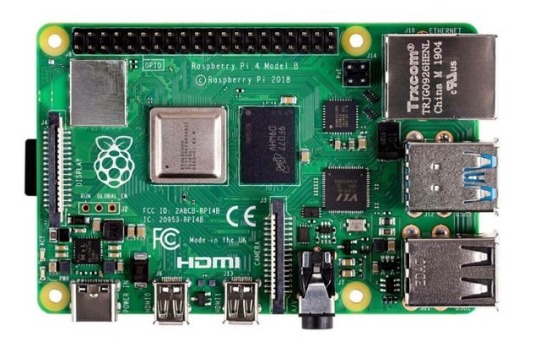
The Raspberry Pi board is a series of small, affordable single-board computers developed by the Raspberry Pi Foundation, a UK-based charity focused on promoting computer science education and digital literacy. Since its launch in 2012, the Raspberry Pi has transformed from a niche educational tool into a versatile platform used in a wide range of applications, from DIY electronics projects to industrial automation.
A Brief History
The first Raspberry Pi, the Model B, was released in February 2012. Designed to promote basic computer science in schools and developing countries, it featured a 700 MHz ARM11 processor, 256 MB of RAM, and basic connectivity options. The success of the Model B led to a rapid expansion of the Raspberry Pi lineup, with various models offering improved performance, more memory, and enhanced connectivity.
Key Features and Models
Raspberry Pi 1 Model B (2012):
Processor: 700 MHz ARM11
Memory: 256 MB RAM
Ports: 2 USB 2.0 ports, HDMI, Composite video, 3.5mm audio jack, Ethernet
Storage: SD card slot
Raspberry Pi 2 Model B (2015):
Processor: 900 MHz quad-core ARM Cortex-A7
Memory: 1 GB RAM
Ports: 4 USB 2.0 ports, HDMI, Composite video, 3.5mm audio jack, Ethernet
Storage: MicroSD card slot
Raspberry Pi 3 Model B (2016):
Processor: 1.2 GHz quad-core ARM Cortex-A53
Memory: 1 GB RAM
Ports: 4 USB 2.0 ports, HDMI, Composite video, 3.5mm audio jack, Ethernet
Wireless: Wi-Fi and Bluetooth
Raspberry Pi 4 Model B (2019):
Processor: 1.5 GHz quad-core ARM Cortex-A72
Memory: Options of 2 GB, 4 GB, and 8 GB RAM
Ports: 2 USB 3.0 ports, 2 USB 2.0 ports, 2 Micro HDMI ports, Ethernet, USB-C for power
Wireless: Wi-Fi and Bluetooth
Raspberry Pi Zero (2015) and Zero W (2017):
Processor: 1 GHz single-core ARM11
Memory: 512 MB RAM
Ports: Mini HDMI, Micro USB OTG, Micro USB for power, GPIO pins
Wireless (Zero W): Wi-Fi and Bluetooth
Applications and Uses
The versatility of the Raspberry Pi has led to its adoption in numerous fields:
Education:
Coding and Programming: Used in schools and educational programs to teach students programming languages such as Python, Scratch, and Java.
Computer Science Concepts: Introduces concepts like hardware, software, and networking.
DIY Projects and Maker Community:
Home Automation: Controls smart home devices, including lights, thermostats, and security systems.
Media Centers: Powers home media centers using software like Kodi.
Retro Gaming: Emulates classic gaming consoles using software like RetroPie.
Industrial and Commercial Applications:
IoT Devices: Serves as a hub for Internet of Things (IoT) devices, enabling data collection and remote control.
Automation and Control Systems: Used in factories and labs for monitoring and controlling equipment.
Research and Development:
Prototyping: Facilitates rapid prototyping of electronic devices and systems.
Data Collection: Gathers data from various sensors in environmental and scientific research.
Community and Ecosystem
The Raspberry Pi has cultivated a vibrant global community of developers, hobbyists, educators, and students. Online forums, tutorials, and community projects provide extensive support and resources for users at all skill levels. The Raspberry Pi Foundation also offers official accessories, including cases, cameras, and expansion boards, further enhancing the functionality of the Raspberry Pi.
Conclusion
The Raspberry Pi board has revolutionized the way people learn about and interact with technology. Its affordability, versatility, and extensive support network have made it an indispensable tool in education, DIY projects, and professional applications. As technology continues to evolve, the Raspberry Pi Foundation remains committed to expanding the capabilities and accessibility of this remarkable platform, ensuring that computing remains within reach for everyone.
3 notes
·
View notes
Text

Type of the Times: A Journal of the Writing and Spelling Reform vol. 11 (1858) by the Longley Brothers
Spelling reformists seek to standardize spelling and orthography to make learning written language easier. Although there have been English language reformists for centuries, spelling reform as a movement grew in popularity in 1800s United States. Reformists of this era include Noah Webster of Merriam-Webster fame, who developed an early American English dictionary, and Isaac Pitman, who developed the Pitman Shorthand for writing efficiently in English.
Type of the Times was a newspaper in Cincinnati, Ohio, during the mid-1800s that advocated for a spelling reform that used Cincinnati Phonotypy, an alphabet based on English phonemes. Elias Longley, the publisher, believed that a standardized orthography would increase written literacy and lead to a more democratic society. In addition to advocating for spelling reform, Type of the Times published articles on education, abolition, women's suffrage, and other reformist topics.
Type of the Times was published in a mix of traditional English orthography and Cincinnati Phonotypy. A sample of articles in the phonotype are included below. Can you read them?




("Michigan Phonetic Convention" pg. 66, "What is Slavery?" pg. 93, "The Love of Home" pg. 35, "A Word to the Wise" pg. 130)
To find out more on Cincinnati Phonotypy and spelling reforms, check out:
English Phonotypic Alphabet Wikipedia article
Elias Longley's First Phonetic Reader (1851)
"Spelling Reform, Phonetic Type, and Woman Suffrage" by Katherine Durack (2020)
The Browne Popular Culture Library (BPCL), founded in 1969, is the most comprehensive archive of its kind in the United States. Our focus and mission is to acquire and preserve research materials on American Popular Culture (post 1876) for curricular and research use. Visit our website at https://www.bgsu.edu/library/pcl.html.
2 notes
·
View notes
Text
Adulting: Essential Tips and Tricks For Success!
New Post has been published on https://sistamagazine.co.za/essential-tips-and-tricks-for-adulting/
Adulting: Essential Tips and Tricks For Success!

Adulting can be challenging, but with some tips and tricks, you can navigate the responsibilities and challenges that come with it more smoothly. Discover crucial tips and tricks for mastering the art of adulting with our comprehensive guide. From financial savvy to time management, health and wellness, and navigating relationships, empower yourself with essential insights to thrive in the complexities of the grown-up world. Start your journey to successful adulthood with practical advice tailored to help you navigate the challenges and responsibilities of life with confidence.
Here are some practical tips for navigating the challenges of grown-up life.
Financial Management:
Budgeting: Create a budget to track your income and expenses. This will help you manage your money effectively.
Emergency Fund: Save a portion of your income for unexpected expenses. Aim for three to six months’ worth of living expenses.
Time Management:
Prioritize Tasks: Make a to-do list and prioritize tasks based on urgency and importance.
Set Goals: Define short-term and long-term goals to stay focused and motivated.
Health and Wellness:
Regular Exercise: Incorporate regular physical activity into your routine for better physical and mental health.
Healthy Eating: Make conscious food choices and maintain a balanced diet.
Professional Development:
Continuous Learning: Stay updated in your field and invest in learning new skills.
Networking: Build professional connections through networking events and social media platforms.
Communication Skills:
Effective Communication: Work on your communication skills to express yourself clearly and listen actively.
Conflict Resolution: Learn how to resolve conflicts calmly and constructively.
Self-Care:
Mindfulness: Practice mindfulness and stress-reduction techniques to maintain mental well-being.
Quality Sleep: Ensure you get enough sleep for better focus and productivity.
Home Management:
Organization: Keep your living space organized to reduce stress and save time.
Cooking Skills: Learn basic cooking skills to save money and eat healthier.
Relationships:
Boundaries: Set healthy boundaries in relationships to maintain balance.
Effective Communication: Apply effective communication in personal relationships as well.
Legal Awareness:
Know Your Rights: Be aware of your legal rights and responsibilities in various aspects of life.
Contracts and Agreements: Understand any contracts or agreements you enter into.
Adaptability:
Problem Solving: Develop problem-solving skills to navigate unexpected challenges.
Flexibility: Be adaptable and open to change when necessary.
Technology Skills:
Digital Literacy: Stay updated on technology trends and enhance your digital literacy.
Cybersecurity: Learn basic cybersecurity practices to protect your personal information.
Environmental Responsibility:
Sustainability: Adopt sustainable practices in your daily life to contribute to a healthier planet.
Remember, adulting is a continuous learning process, and it’s okay to seek help or guidance when needed. Everyone’s journey is unique, so find what works best for you and tailor these tips to fit your individual circumstances
(adsbygoogle = window.adsbygoogle || []).push();
6 notes
·
View notes